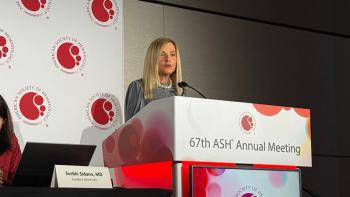
Cannabis Risks and Benefits in Cancer Symptom Management: Much Remains Unknown
Oncologists, patient advocates, patients, and other stakeholders from around the world gathered to hear different perspectives regarding the use of cannabis in symptom management for patients with cancer. Panelist after panelist went up to present available data, and each reiterated the same point: We need more research.
Open chairs were scarce as a session at the 2019 American Cancer Society Annual Meeting titled “Is There a role for Cannabis in Cancer Symptom Management?” was set to begin. The session featured knowledgeable oncologists Mellar Davis, MD, of Geisinger Health System; Claude Cyr, MD, of McGill University; Brooke Worster, MD, of Thomas Jefferson University; and Ilana Braun, MD, of the Dana-Farber Cancer Institute. The meeting took place May 31 to June 4, 2019 in Chicago, Illinois.
Oncologists, patient advocates, patients and other stakeholders from around the world gathered to hear different perspectives regarding the use of cannabis in symptom management for patients with cancer. Panelist after panelist went up to present available data, and each reiterated the same point: We need more research.
As it stands right now, the legal landscape of cannabis use, particularly in the United States, is puzzling, to say the least.
This creates problems in terms of prescribing, administering, and even researching the drug. Additionally, it presents a problem for patients with cancer who do want to access it—sometimes at the permission or urging of their provider. These same patients can walk into a dispensary and be offered products that have not gone under FDA review for safety, efficacy, or potency.
“Cannabis is commonly used by patients during cancer therapy, frequently without the oncologist’s knowledge,” said Davis. This presents a problem because, as each panelist pointed out, “how cannabis influences cancer therapy and cancer course is completely unknown,” he said.
Cyr began his presentation by taking a poll of the audience. He asked, “How many people feel uncomfortable offering cannabis to patients?” Although a decent number of oncologists raised their hands, it was noted that it was significantly less than in recent years. He then asked the audience why they were uncomfortable, and the response was largely that they were waiting for more evidence.
Cyr’s presentation was somewhat unconventional by usual standards of cannabis use in patients with cancer. He explained that many of the most common adverse events, euphoria, aversive memory extinction, slowed down sense of time, and relaxation, among others, could actually be positive for patients with cancer.
“If you have a patient who is nearing end of life, who is feeling extremely depressed, well cannabis may be the safest drug to prescribe that elicits euphoria,” he said. “Though aversive memory extinction may seem like a bad thing for other patients, I would offer that cancer patients may not want to remember every minute of sitting through chemotherapy. And for patients who consistently report feeling like their lives are slipping away from them and that they don’t have much time less, a slowed down sense of time could be a great thing.”
Although the available research is mixed regarding the risks and benefits of cannabis use in patients with cancer, Worster works with the geriatric population and stressed that she has some different concerns than her colleagues working with younger patients with cancer.
“Age is just a number. There are large differences in the rate of aging, and different organ systems age at different rates. An individual’s age, per se, is not the problem; however, it does raise the statistical likelihood of certain events—such as falls—if patients are initiating cannabis use,” she said.
In this population, she explained, adverse events of cannabis use, such as dizziness could have life-threatening consequences.
When moving forward in this space, though the law conflicts both across states, as well as federally, Braun offered a few closing thoughts: “Healthcare providers should become versed in the endocannabinoid system the same way we’re versed in other systems. Cannabis’ benefits and risk should be included in medical education and CME [continuing medical education] curricula. Medical infrastructure should take medical marijuana into account. Everyone should advocate for loosening of restrictions on medical marijuana clinical trials, and professional societies, such as ASCO, should develop consensus guidelines either for or against the prescribing of these products.”
Newsletter
Stay ahead of policy, cost, and value—subscribe to AJMC for expert insights at the intersection of clinical care and health economics.









































